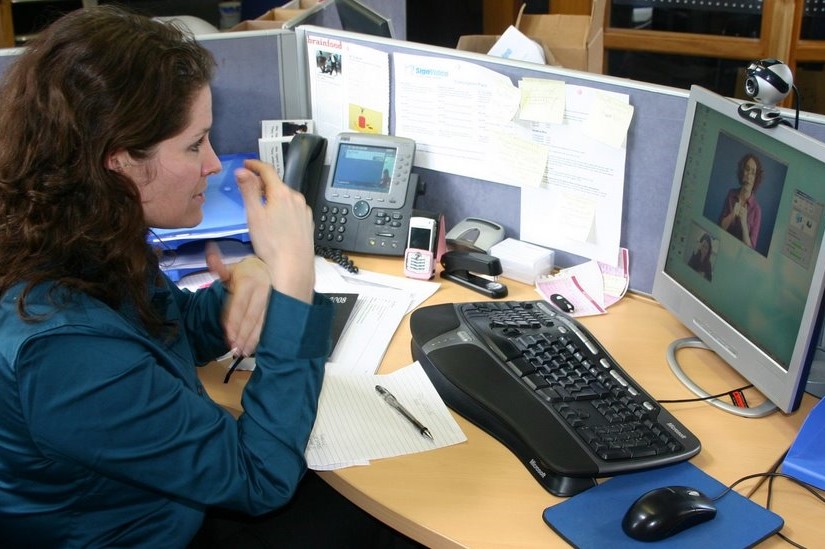Tips for Housing Providers to Provide Equitable Service to Deaf and Hard of Hearing Consumers
By Nick Adjami, Kate Scott, and Sara Surface
August 12, 2021
Roughly one million individuals in the U.S. are deaf, and another ten million are hard of hearing.[1] Washington, DC has earned a reputation as a hub of Deaf culture thanks in large part to Gallaudet University, a private college for d/Deaf and hard of hearing students. The Washington Post has described the District’s H Street neighborhood as a “nexus of deaf youth culture.”[2] Still, there are many hearing people who are unfamiliar with the needs of d/Deaf people and the various tools that make it possible for hearing people and d/Deaf or hard of hearing people to communicate. This blog post seeks to dispel some common misconceptions and help housing providers to better serve d/Deaf and hard of hearing consumers.
First, you’ll notice the word “deaf” is sometimes capitalized and sometimes left lowercase. Generally, the lowercase “deaf” is used in reference to the audiological condition of not hearing. People who use it to describe themselves might not identify as part of the uppercase Deaf community. The uppercase “Deaf” refers to a particular group of people who share a language (sign language) and a culture, or one’s identity within that group.[3] For most people in this group, Deaf-ness is an identity trait to take pride in, rather than a hearing “loss” or condition as others might define it.[4] Some individuals may not have a preference on capitalization or move in and out of the categories throughout their life. In this blog post, we’ll frequently use “d/Deaf” to refer as expansively as possible to both categories.
Many, but not all, d/Deaf people in the United States communicate using American Sign Language (ASL). ASL is not a manual expression of English. It is its own language with its own vocabulary, grammar, and syntax. Roughly five percent of Deaf people in the U.S. are fluent in written English, while most relate to it as a foreign language, with which they may or may not have some capability.[5] This is especially true for people who were born deaf and learned sign language young. People who became deaf later in life, on the other hand, are less likely to be fluent in sign language and may very well prefer to communicate in written and/or spoken English.
There are many different dialects of ASL used throughout the country and by different groups of people. For example, Black American Sign Language (BASL) developed in segregated southern schools and continues to be used in the Black Deaf community.[6]
Many d/Deaf people have phones and make phone calls, and may use an assistive device to do so. The most common technologies d/Deaf people use to make calls are Video and IP Relay services.
Video Relay is the most popular choice for people whose first language is ASL. The service allows a d/Deaf person to communicate over the phone with a hearing person using ASL, as opposed to written or spoken English. As a d/Deaf person signs, an interpreter translates to spoken English for the hearing person. Similarly, the interpreter translates the hearing person’s spoken statements into ASL for the d/Deaf caller.

Photograph of a Deaf woman using a Video Relay
Service to communicate with a hearing person,
courtesy of Significan’t SignVideo Services.
IP Relay calls similarly facilitate conversation between d/Deaf and hearing individuals, but using written English as opposed to ASL. On an IP Relay call, a Communications Assistant (CA) types the hearing person’s spoken statements so that the d/Deaf person can read them on their smartphone or computer. The CA also reads aloud the d/Deaf person’s typed messages for the hearing person. Often, there are periods of brief delays between messages as the CA communicates back and forth. Hearing individuals who do not understand the delays – or automated phone systems engineered to time out – may hang up on IP Relay users during these delays. To ensure equal access for d/Deaf and/or hard of hearing individuals, housing providers should make sure they do not hang up on IP Relay users during these delays.
A TTY or Text Telephone is an assistive device that, like Video and IP Relay, facilitates conversation between d/Deaf and hearing individuals. The device is paired with TRS (Telecommunications Relay Service) allowing an operator to type the hearing person’s spoken statements so that the d/Deaf person can read them on their TTY display. The operator also reads aloud the d/Deaf person’s typed messages for the hearing caller. Many hearing people continue to think of TTY as the primary way d/Deaf people communicate, since it was the first relay service connecting d/Deaf and hearing callers, but its popularity has waned since the advent of Video and IP Relay. Housing providers should keep this in mind before assuming TTY will be a sufficient accommodation for the majority of d/Deaf and hard of hearing consumers.

Photograph of a TTY, courtesy of Jesper Rautell Balle.
Housing providers should familiarize themselves with how these technologies work to ensure they provide equal service to d/Deaf and hard of hearing renters. Whether a tenant or prospect prefers to communicate by email, Video Relay, IP Relay, or TTY, the housing provider should comply with that preference. For tips on receiving and communicating via TRS calls, visit this resource from ada.gov and this resource from the National Business & Disability Council at the Viscardi Center.
Under the law, d/Deaf people have a right to equal access. The Fair Housing Act makes it illegal to discriminate on the basis of disability. As such, people with disabilities are entitled to equitable treatment in the process of applying for a rental unit and equal opportunity to access and enjoy their homes. Despite these protections, discrimination against d/Deaf and hard of hearing renters unfortunately still occurs.
One type of discrimination that the Fair Housing Act prohibits is offering different terms and conditions to applicants or residents on the basis of a protected class, such as disability. During a recent civil rights testing investigation at the Rodney, an apartment building in Northwest DC, the ERC uncovered a number of discriminatory actions against Deaf testers. For example, when trying to reach a leasing agent, Deaf testers using IP Relay faced significantly longer hold times and were more likely to be disconnected from a call than were hearing testers. Additionally, in one case, a hearing tester was quoted a lower rent price and told about more available units than the Deaf tester.
Another type of discrimination under the Fair Housing Act is the refusal to grant people with disabilities reasonable accommodations or reasonable modifications in housing. For example, if a d/Deaf tenant asks their housing provider to always communicate with them via email as a reasonable accommodation, the housing provider should grant and implement that request. Another common type of reasonable accommodation request is for a tenant to be allowed a service animal or emotional support animal in a “no pets” building.
Discriminatory actions unfairly restrict d/Deaf people’s access to housing, and frustrate the goal of building diverse, integrated communities. People with disabilities have been advocating for integrated housing for decades and see it as central to the wellbeing of the disabled community. In an interview,[7] Adam Ballard, housing and transportation policy analyst at Access Living, defined integrated housing by saying:
“So much of the disability housing that exists today is in some sort of segregated setting, whether it’s nursing homes, congregate care facilities, group homes, or other settings designed only for people with disabilities. In contrast, integrated housing is housing that is integrated into the fuller community, with the same range of housing options available to people without disabilities.”
His colleague, managing attorney Kenneth M. Walden, added:
“When housing is segregated, it reinforces negative stereotypes about people with disabilities — that the disabled community has to be set apart, that it must be approached in a charitable way. Segregated housing implies that the population is housed, even warehoused, whereas integrated housing is about living in a community.”
When housing providers fail to provide equal treatment and services to people who are d/Deaf or hard of hearing, they contribute to maintaining the unfair segregation of people with disabilities. Housing providers must work proactively to provide equitable treatment to all prospects and tenants.
Not only is it the right thing to do; it’s the law.
References:
[1] Mitchell, Ross E. “How many deaf people are there in the United States? Estimates from the Survey of Income and Program Participation.” Journal of deaf studies and deaf education vol. 11, 1 (2006): 112-119. doi:10.1093/deafed/enj004.
[2] Samuels, Robert. “D.C.’s H Street embedded with deaf culture.” Washington Post (2015): https://www.washingtonpost.com/local/dcs-h-street-embedded-with-deaf-culture/2013/07/15/efd54732-e3f3-11e2-a11e-c2ea876a8f30_story.html.
[3] National Association of the Deaf. “Community and Culture – Frequently Asked Questions.” https://www.nad.org/resources/american-sign-language/community-and-culture-frequently-asked-questions/.
[4] Khalifa, Ahmed. “What’s the difference between Deaf with a capital ‘d’ and deaf with a small ‘d’?” Hear Me Out (2018): https://hearmeoutcc.com/capital-d-small-d-deaf/.
[5] Ludden, David. “Can You Read a Language You Can’t Hear?” Psychology Today (2015): https://www.psychologytoday.com/us/blog/talking-apes/201507/can-you-read-language-you-can-t-hear.
[6] Waller, Allyson. “Black, Deaf, and Extremely Online.” New York Times (2021): https://www.nytimes.com/2021/01/23/us/black-american-sign-language-tiktok.html.
[7] Berlin, Loren. “Using Housing to Fight Discrimination against People with Disabilities.” Urban Institute Next50 (2019): https://next50.urban.org/article/using-housing-fight-discrimination-against-people-disabilities.
———
If you believe you may have experienced discrimination in housing, you can contact the Equal Rights Center. To report your experience, please call 202-234-3062 or email info@equalrightscenter.org.

